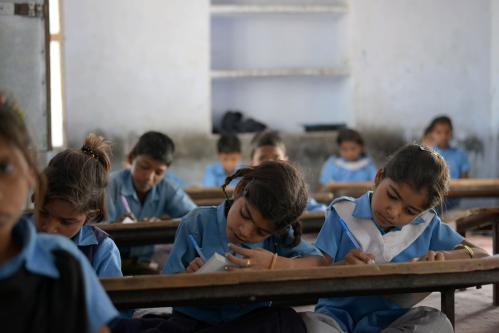On December 12th, Brookings will host a webinar exploring the potential applications for impact bonds in health. Further details and the registration page are available here.
Tomorrow, the world’s 5th development impact bond (DIB) will launch at the Global Entrepreneurship Summit in India. This new impact bond aims to improve maternal and neonatal mortality rates in the state of Rajasthan, which are among the highest in India. The deal has the potential to reach up to 600,000 pregnant women with improved care during delivery and save the lives of up to 10,000 women and newborns over five years, tying the achievement of impact metrics to an $8 million outcome fund.
Impact bonds, first rolled out in high-income countries, offer a relatively new tool for financing development—in a social impact bond (SIB), outcomes are funded by a government entity, while in a DIB, the outcome funder is an external party, such as a development agency. At the core of both of types of bonds is the principle of payment by results: investors provide service providers with upfront capital and outcome funders only pay them their principal plus a return if pre-agreed impact metrics are achieved. By focusing attention on results, DIBs and SIBs provide an opportunity to deliver services with more flexibility, boost the effectiveness of spending, and reward interventions that achieve measurable impacts for populations in need.
The first DIB, launched in Peru in 2015, provided technical assistance to rural communities to improve sustainable coffee and cocoa production, while the second, also in India, aimed to increase school enrollment for girls and improve learning outcomes. This is the third DIB contracted this year, following the ICRC Programme for Humanitarian Impact Investment and the Village Enterprise Graduation DIB. The first SIB in a middle-income country was contracted in Colombia earlier this year, bringing the total number of impact bonds in low- or middle-income countries to six (five DIBs and one SIB). Earlier this year, Brookings published a report documenting the learnings from impact bonds contracted in developing countries, as well as an overview of those in design.
What intervention does the DIB finance and for whom?
Service providers will work with up to 440 private medical facilities to help them gain accreditation as quality maternal care providers. Two certification process will benchmark quality standards: those of the National Accreditation Board for Hospitals and Healthcare Providers (NABH) and those of the Federation of Obstetrics and Gynaecological Societies of India (FOGSI), which recently launched the Manyata certification. The intervention will support the facilities to work towards the achievement of both certifications, the NABH Entry Level standards and the FOGSI Manyata clinical standards for maternal care (summarized in Box 1 and 2, respectively).
Who is involved?
The outcome funders for the impact bond are USAID and Merck for Mothers, while the Government of Rajasthan is planning to commission outcomes in Year 4 and 5. The intermediary for the project is Palladium, an advisory and management organization. The cornerstone investor, with an upfront capital commitment of up to $3 million, is the UBS Optimus Foundation, who will be using a combination of foundation and UBS client funds. Services will be provided by the Hindustan Latex Family Planning Promotion Trust (HLFPP) and Population Services International (PSI). All implementing partners will also take an investment position in the impact bond. Palladium, PSI and HLFPPT will together provide 20 percent of the investment capital, and will be—exposed and rewarded—pari passu with the funds channeled through the UBS Optimus Foundation.
What does success look like?
The outcome metrics for this impact bond focus on the readiness for the NABH and FOGSI Manyata certifications (see Table 1). To achieve the full payment of $18,000 per facility, each facility will need to achieve at least 50 percent of total points available in each NABH chapter (see Box 1), and at 100 percent of least 11 of the 16 FOGSI standards (see Box 2). To achieve 25 percent of the full outcome payment ($4,500), a facility needs to achieve at least 30 percent of the total points in each NABH chapter, as well as 100 percent of at least 6 of the FOGSI standards.
The future of impact bonds in health
The application of DIBs to the health sector is an exciting development, particularly as it relates to the vulnerable target population of mothers and newborn infants. Previous research has focused on applying them to early childhood development in low- and middle-income countries. Health provides especially promising opportunities for impact bonds, given the potential for high future returns, both to individuals and to wider society. Including this DIB, only 13 of 100 contracted impact bonds have been in health, however, there are many in design phase, including 10 in developing countries. We look forward to keeping a close eye on the results of these early DIBs, as well as the multiple deals in the pipeline.
Table 1: Outcome metrics for Maternal and Newborn Health Impact Bond
| Payment per facility | Metric | |
| Full Payment | $18,000 | >=50% of the total points available in each NABH chapter (10 in total) AND 100% of at least 70% (11) of the applicable FOGSI standards (16 in total). |
| Progressive metric | $4,500 | >=30% of the total points available in each NABH chapter (10 in total) AND 100% of at least 40% (6) of any of the applicable FOGSI standards (16 in total) |
|
Box 1: NABH Chapters 1. Access, Assessment and continuity of care (AAC) |
|
Box 2: FOGSI Standards 1. Provider screens for key clinical conditions that may lead to complications during pregnancy |
The Brookings Institution is committed to quality, independence, and impact.
We are supported by a diverse array of funders. In line with our values and policies, each Brookings publication represents the sole views of its author(s).








Commentary
Rallying behind maternal and newborn health: A new impact bond launches in India
November 29, 2017